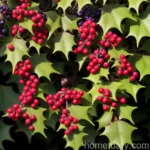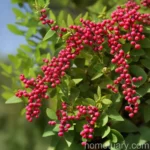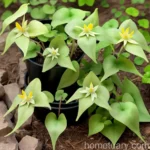The Amazing Creeping Mahonia (Mahonia repens)
Creeping mahonia, scientifically known as Mahonia repens, is a delightful evergreen plant that offers an array of benefits for landscapes, gardens, and the environment. Boasting striking features and versatile applications, this plant has captured the interest of both enthusiasts and professionals in horticulture and landscaping. In this comprehensive guide, we will explore all aspects of the creeping mahonia, including its growth habits, care requirements, maintenance tips, benefits, and ecological contributions. Additionally, we will delve into its cultural significance, landscape applications, environmental impact, and even its culinary and medicinal uses. By the end of this article, you will have an in-depth understanding of this remarkable plant and its role in creating vibrant, sustainable environments.
What is Creeping Mahonia (Mahonia repens)?
Creeping mahonia, or Mahonia repens, is a low-growing, spreading, evergreen shrub that belongs to the Berberidaceae family. This native plant is primarily found in the western regions of North America, including areas in the Rocky Mountains, the Pacific Northwest, and the southwestern United States. It thrives in diverse habitats such as woodlands, slopes, and rocky areas, providing essential ecological functions in its natural range.
The plant is characterized by its unique architectural features, including holly-like, compound leaves with spiny edges, and attractive clusters of bright yellow flowers that appear in late spring. These blossoms give way to clusters of bluish-black berries in summer, which persist through fall and provide food for birds and other wildlife. The lush foliage and ornamental berries make creeping mahonia a valuable addition to gardens, naturalistic plantings, and erosion-prone landscapes.
Key Takeaways – Creeping Mahonia (Mahonia repens)
- Scientific Name: Mahonia repens
- Family: Berberidaceae
- Common Names: Creeping mahonia, creeping barberry, Oregon grape-holly
- Plant Type: Evergreen shrub
- Native Range: Western regions of North America
- Notable Features: Holly-like leaves, bright yellow flowers, bluish-black berries
- Special Attributes: Wildlife attraction, erosion control, medicinal and culinary uses
Now, let’s delve deeper into the various aspects of caring for creeping mahonia and maximizing its potential in diverse settings.
Culture
Cultivating creeping mahonia successfully involves understanding its specific cultural preferences and requirements, including soil, sunlight, water, and maintenance practices. By aligning with the plant’s natural tendencies, we can create an environment that encourages healthy growth and enhances its ecological contributions.
Key Cultural Factors
When considering the cultural requirements of creeping mahonia, several key aspects come into play:
-
Soil: Creeping mahonia thrives in well-drained, acidic soils with good organic content. It has a preference for slightly moist but not waterlogged conditions, making well-draining soils essential for its health and vitality.
-
Sunlight: While it can tolerate some shade, creeping mahonia generally performs best in partial to full sunlight. When planted in shadier locations, its flowering may be slightly reduced, but it remains an attractive evergreen presence.
-
Water: Adequate moisture is crucial, especially during the plant’s establishment phase. Once mature, creeping mahonia exhibits good drought tolerance, but regular watering during extended dry periods can help maintain its vigor and overall appearance.
-
Fertilizer: As a low-maintenance plant, creeping mahonia typically does not require heavy feeding. However, a light application of a balanced, slow-release fertilizer in spring can support its growth and flowering.
-
Pruning: Minimal pruning is generally needed, mainly to shape the plant or remove damaged or overgrown branches. Pruning can be carried out after flowering to maintain the desired form.
With these cultural considerations in mind, gardeners and landscapers can create suitable environments for creeping mahonia’s success.
Uses
Landscape Applications
Creeping mahonia offers a range of uses in landscape design, where its compact growth habit, attractive foliage, and ornamental features can be leveraged for various aesthetic and functional purposes. Some common landscape applications include:
-
Groundcover: Its low, spreading growth habit makes creeping mahonia an excellent groundcover plant, particularly for slopes, banks, and areas requiring soil stabilization.
-
Borders and Edging: The plant’s dense and low-growing nature lends itself well to defining borders and edges within garden beds and along pathways.
-
Woodland Gardens: Given its native habitat, creeping mahonia is a natural fit for woodland or shade gardens, where it can thrive in the dappled light and contribute to a diverse plant community.
-
Rock Gardens: The textural interest of the plant’s holly-like leaves and the seasonal appeal of its flowers and berries make it a valuable addition to rock gardens, adding visual appeal and year-round interest.
-
Erosion Control: With its propensity for spreading and dense growth, creeping mahonia effectively helps prevent soil erosion, particularly on slopes and embankments.
Medicinal and Culinary Uses
In addition to its ornamental value and landscape benefits, creeping mahonia has historical uses in traditional herbal medicine and culinary practices. The roots and bark contain alkaloids with potential medicinal properties, leading to their use in herbal remedies for various ailments.
The bright blue berries, while tart, are edible and can be used in recipes for jams, jellies, and beverages. However, it is important to note that these berries should be consumed in moderation and with caution, as they contain compounds that require careful handling.
By exploring and understanding these diverse uses, we can appreciate the multifaceted nature of creeping mahonia and its potential contributions to human health and well-being.
Water
The water needs of creeping mahonia are essential to consider for its successful growth and long-term health. Understanding the plant’s requirements and providing appropriate moisture levels can ensure its vigor and vitality in diverse garden and landscape settings.
Mahonia repens Watering Needs
When it comes to watering creeping mahonia, several key points should be kept in mind:
-
Establishment Phase: Newly planted creeping mahonia should be watered regularly to support root establishment and initial growth. Providing consistent moisture during this phase promotes strong development.
-
Mature Plants: Once established, creeping mahonia displays good drought tolerance and can withstand periods of reduced moisture. However, during prolonged dry spells, particularly in hot climates, supplemental watering can help maintain its overall health and appearance.
-
Signs of Stress: Monitoring the plant for signs of stress, such as wilting or browning of leaves, can indicate the need for additional watering. Adjusting watering frequency based on seasonal variations and local climate conditions is crucial for its well-being.
By tailoring the watering practices to the specific needs of creeping mahonia, gardeners can optimize its performance and contribute to sustainable water management in landscaping.
Sunlight
Determining the appropriate sunlight conditions for creeping mahonia is vital for its growth, flowering, and overall appearance. By understanding its sunlight preferences, gardeners can position the plant in locations that maximize its potential and contribute to visually pleasing and vibrant landscapes.
Best Conditions for Creeping Mahonia
In terms of sunlight requirements, consider the following factors:
-
Partial to Full Sun: Creeping mahonia generally thrives in locations with partial to full sunlight. These conditions promote robust growth, abundant flowering, and the development of its characteristic berries.
-
Shade Tolerance: While it prefers ample sunlight, creeping mahonia exhibits some tolerance to shaded areas, making it adaptable to a range of garden and landscape settings.
-
Flowering and Berries: Providing adequate sunlight encourages prolific flowering and the subsequent formation of the plant’s attractive bluish-black berries, enhancing its ornamental appeal.
By selecting suitable locations that offer the right balance of sunlight, gardeners can ensure that creeping mahonia flourishes and contributes to the visual and ecological richness of outdoor spaces.
Fertilizer
Understanding the fertilizer needs of creeping mahonia is crucial for maintaining its health and promoting optimum growth. By providing appropriate nutrients, gardeners can support the plant’s vigor and ornamental characteristics, ensuring a striking and resilient presence in gardens and landscapes.
Fertilizing Creeping Mahonia
Several key points can guide the fertilization of creeping mahonia:
-
Balanced Fertilizer: A light application of a balanced, slow-release fertilizer in spring can provide the necessary nutrients to support the plant’s growth and flowering. Opt for a fertilizer with a balanced NPK ratio to ensure comprehensive nourishment.
-
Moderation: As a relatively low-maintenance plant, creeping mahonia does not typically require heavy feeding. Avoid excessive fertilization, as it can lead to unnatural growth and may not benefit the plant in the long run.
-
Organic Amendments: In lieu of synthetic fertilizers, organic amendments such as compost and well-rotted manure can be beneficial for maintaining soil fertility and supporting the plant’s overall well-being.
By adhering to a balanced and moderate approach to fertilization, gardeners can sustain the health and vitality of creeping mahonia, contributing to its lasting success in diverse garden and landscape contexts.
Soil
The soil requirements of creeping mahonia play a crucial role in its overall health, growth, and resilience. Understanding the plant’s preferences and providing suitable soil conditions are essential for creating an environment where it can thrive and fulfill its ornamental and ecological potential.
Best Soil for Creeping Mahonia
In establishing optimal soil conditions for creeping mahonia, consider the following factors:
-
Drainage: Well-drained soil is paramount for the plant’s health, as it abhors waterlogged conditions. Amending heavy or compacted soils with organic matter can improve drainage and create a more hospitable environment.
-
Acidity: Creeping mahonia prefers soil with a slightly acidic pH, typically within the range of 5.0 to 6.5. Conducting a soil test and adjusting the pH as needed can help provide the plant with an ideal growing medium.
-
Organic Matter: Incorporating organic matter, such as compost or leaf mold, enriches the soil and supports beneficial microbial activity, contributing to the plant’s overall vigor and vitality.
-
Moisture Balance: Striking a balance between moisture retention and drainage is essential, ensuring that the soil provides adequate water while preventing waterlogging, especially during periods of heavy rainfall.
By creating a soil environment that aligns with the specific preferences of creeping mahonia, gardeners can set the stage for its successful establishment and sustained growth.
Pruning
Pruning is an essential maintenance practice for promoting the health, appearance, and longevity of creeping mahonia. By addressing overgrowth, shaping the plant, and rejuvenating older specimens, pruning contributes to maintaining the plant’s vigor and enhancing its ornamental qualities.
Creeping Mahonia Pruning Techniques
When approaching the pruning of creeping mahonia, consider the following techniques and guidelines:
-
Timing: Pruning is typically carried out after flowering, usually in late spring or early summer. This timing allows the plant to complete its blooming cycle before undergoing shaping and maintenance.
-
Shaping: Trimming back excessive growth and shaping the plant can help maintain its desired form and prevent it from overtaking surrounding areas. Focus on removing overly leggy or wayward branches to encourage a compact, dense growth habit.
-
Damaged or Dead Growth: Identifying and removing damaged, diseased, or dead branches supports the plant’s health and prevents the spread of potential ailments.
-
Rejuvenation: For older or neglected specimens, rejuvenation pruning can be employed to invigorate the plant by removing older stems and encouraging new growth from the base.
By employing these pruning techniques and practices, gardeners can ensure that creeping mahonia remains an attractive and vibrant presence in gardens and landscapes.
Propagation
The propagation of creeping mahonia offers an opportunity to multiply and share this valuable plant, whether for personal enjoyment, landscaping projects, or ecological restoration efforts. By understanding the various propagation methods and best practices, individuals can successfully propagate and establish new plants with relative ease.
How to Propagate Creeping Mahonia
Several effective propagation methods can be employed to multiply creeping mahonia:
-
Seed Propagation: Collecting and germinating the plant’s seeds is one way to propagate creeping mahonia. However, bear in mind that this method may take time to yield sizable plants and may result in some variability.
-
Division: Dividing mature plants into smaller sections can be an efficient way to propagate creeping mahonia, particularly for established specimens that have developed multiple stems and root systems.
-
Softwood Cuttings: Taking softwood cuttings in spring or early summer can lead to successful propagation, as these cuttings have the potential to develop roots and produce new plants with characteristics similar to the parent organism.
By exploring these methods and selecting the most suitable approach for individual circumstances, gardeners and enthusiasts can propagate creeping mahonia and expand its presence in varied settings.
Container Popularity
The appeal of creeping mahonia as a container plant extends to diverse gardening and landscaping preferences. Whether used as a standalone feature or as part of mixed container arrangements, its compact growth habit and ornamental presence make it a compelling choice for container gardening.
Creeping Mahonia for Containers
When considering the use of creeping mahonia in containers, several points come into play:
-
Compact Growth: The plant’s low, spreading nature makes it well-suited for container culture, allowing it to serve as a groundcover or a cascading element in mixed container ensembles.
-
Versatile Design: Creeping mahonia can impart visual interest, texture, and evergreen appeal to container displays, adding year-round charm and vibrancy to outdoor living spaces.
-
Portability: Utilizing creeping mahonia in containers provides the flexibility to relocate the plant as needed, enabling changes in garden and landscape arrangements and accommodating seasonal variations.
By harnessing the allure and adaptability of creeping mahonia in container gardening, enthusiasts can elevate their outdoor spaces and enjoy the plant’s charismatic presence in a mobile and versatile manner.
Common Diseases
While generally resilient, creeping mahonia is prone to certain diseases that can affect its appearance and overall well-being. Familiarizing oneself with these common ailments and their management strategies is crucial for maintaining the plant’s health and vitality.
Disease Diagnosis
Several prevalent diseases that affect creeping mahonia include:
-
Powdery Mildew: This fungal disease manifests as a powdery white coating on the plant’s leaves, often leading to stunted growth and distorted foliage.
-
Leaf Spot: Leaf spot diseases cause conspicuous dark, sunken lesions on the plant’s leaves, potentially leading to premature leaf drop and reduced vigor.
-
Root Rot: Excessive moisture and poor drainage can contribute to root rot, resulting in the decay of the plant’s root system and subsequent wilting and decline.
-
Anthracnose: Anthracnose infections may result in sunken lesions on leaves or stems, potentially leading to dieback and weakened plant vigor.
By recognizing the symptoms associated with these diseases and implementing appropriate management practices, such as proper watering, sanitation, and, if necessary, targeted treatments, gardeners can mitigate the impact of these ailments and protect the health of creeping mahonia.
Common Pests
Various pests may target creeping mahonia, posing potential threats to its foliar health and overall vitality. Monitoring for signs of pest activity and implementing integrated pest management measures can help safeguard the plant from infestations and minimize associated damage.
Managing Pest Infestations
Some common pests that may affect creeping mahonia include:
-
Aphids: These small, sap-sucking insects can congregate on the plant’s new growth, leading to distorted leaves and reduced vigor.
-
Scale Insects: Scale infestations may manifest as raised, waxy protrusions on the plant’s stems and foliage, potentially hindering its overall health and appearance.
-
Spider Mites: Spider mites can cause stippling and discoloration on the plant’s leaves, often as a result of their piercing-sucking feeding habits.
-
Caterpillars: Certain caterpillar species may feed on creeping mahonia’s foliage, leading to defoliation and potential stress on the plant.
Implementing proactive measures, such as regular inspection, promoting beneficial predator populations, and, if necessary, employing targeted pest control methods, can help manage pest pressures and maintain the plant’s long-term health and ornamental appeal.
Botanist’s Tips
As experienced botanists and horticulturists, here are some valuable insights and tips that can enhance the success and enjoyment of growing creeping mahonia:
-
Native Plant Benefits: Embracing native plants such as creeping mahonia can support ecological diversity, provide habitat for wildlife, and enhance the resilience of local landscapes.
-
Companion Planting: Pairing creeping mahonia with compatible companion plants can create visually harmonious and functionally synergistic garden compositions, enriching outdoor environments.
-
Year-Round Interest: Leveraging creeping mahonia’s evergreen nature and seasonal features can contribute to year-round interest in gardens and landscapes, fostering enduring visual appeal.
-
Soil Improvement: Incorporating creeping mahonia in soil improvement efforts can contribute to enhanced soil structure, microbial activity, and overall fertility, benefiting other plants within the ecosystem.
By embracing these insights and applying them to the cultivation and integration of creeping mahonia, enthusiasts and professionals can maximize the plant’s potential and ecological contributions.
Fun Facts
To further appreciate the charm and value of creeping mahonia, here are some intriguing and delightful fun facts about the plant:
-
Wildlife Interaction: Creeping mahonia’s berries attract a variety of bird species, contributing to avian biodiversity and providing a vital food source, especially in late summer and fall.
-
Native Heritage: As a native plant, creeping mahonia holds cultural significance and historical uses among Indigenous communities, embodying a rich legacy of traditional practices and knowledge.
-
Color Schemes: Beyond its ornamental foliage and berries, creeping mahonia’s color palette can inspire creative color schemes and design concepts, enriching and enlivening garden landscapes.
-
Drought Tolerance: The plant’s resilience in arid conditions and its ability to thrive without excessive water exemplify its adaptability and ecological relevance in water-wise gardening approaches.
By highlighting these fun and intriguing facets of creeping mahonia, we celebrate its unique character and contributions to inhabited and natural spaces alike.
Links to External Resources
To deepen your understanding of creeping mahonia and discover additional insights, here are some valuable external resources:
- Wildflower.org – Creeping Mahonia
- USDA Plants Database – Mahonia repens
- Colorado State University Extension – Mountain Mahogany and Mahonia
- Washington Native Plant Society – Creeping Mahonia
- Lady Bird Johnson Wildflower Center – Mahonia repens
Exploring these resources can provide in-depth botanical, horticultural, and ecological perspectives on creeping mahonia, enriching your knowledge base and inspiring further engagement with this remarkable plant.
Conclusion
Creeping mahonia, or Mahonia repens, captivates enthusiasts and professionals alike with its graceful, evergreen presence, ornamental features, and diverse ecological contributions. Through a nuanced exploration of its cultural preferences, landscape uses, environmental benefits, and historical significance, we have uncovered the multifaceted appeal and relevance of this native plant. By aligning cultivation















